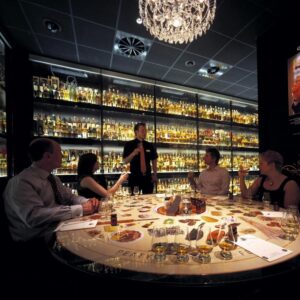How to host a Scotch Whisky Tasting Party
Be it in company at your home or virtually over video calls Scotch has always brought people together. The stories behind the drams and our own personal tastes and responses to each whisky, make for both the perfect ice-breaker in new company as well as a great conversation (or even a heated debate!) with old friends. Whether you are celebrating Burns Night (25th January), St Andrew’s Day (30th November) or your own gathering this blog has all the hints and tips you would need to host your very own Scotch whisky tasting party. And who better to take you through the process of hosting your own whisky tasting than Master of the Quaich, Julie Trevisan-Hunter! Find out how to put together a whisky tasting to remember by following the steps below…

“Both Scotch whisky and Scotland’s national Bard (poet) Robert Burns are known and cherished throughout the world, and what better time for both Scots and Scots-at-heart across the globe to bring the two together than Burns Night? Robert Burns was both a farmer and customs officer so his knowledge of Scotch, from growing the barley through to enjoying the finished dram, makes him a truly great poet of Scotch! (there’s a nice potted history of Scotch whisky history here)
Leaving the accompanying poetry aside (you’ll find plenty of it on the Scottish Poetry Library website), here are some ideas to run a perfect Scotch whisky tasting party as part of your Burns Supper celebrations or indeed at any other time.
Your duty to your guests is to help them to find their very own favourite Scotch whisky, and with well over 120 single malt distilleries contributing to further thousands of blends it’s a daunting task, but with a few well-chosen drams you’ll easily be able to accommodate everyone’s tastes.

How to compare whiskies to find your perfect Scotch
We are going to concentrate on comparing Single Malt Scotch Whisky rather than Blends, simply because they offer the widest contrasts. However, never forget the Blends or you’ll be missing out on some tremendous drams, accounting for over 90% of Scotch whisky sales! Perhaps welcome guests with a Blended Scotch and serve it whatever way your guests like. Everyone knows that Scotch is incredibly versatile and enjoyed in different ways all over the world – I love that we don’t have strict rules so for your arrival drink anything goes! Why not try an amazing Scotch whisky cocktail recipe as a cracking opener to your whisky tasting party? If you are running a virtual party then get everyone to come up with their own cocktail – a classic, their own variation or even something completely new.
When it comes to the single malts I suggest sampling one whisky against another in a ‘comparative Scotch tasting’ (much like we run at the Scotch Whisky Experience) which highlights both the dramatic and the more subtle differences and helps you on your journey to discover your perfect dram. It is a tasting experience for whisky novices and your enthusiast friends alike – if you are new to Scotch you’ll be able to detect the big punchy contrasts and if you know Scotch like the back of your hand then you’ll be picking out the delicate and subtle similarities – everyone’s happy!
So, onto the tricky part – which whiskies to choose for your tasting? Based on running thousands of tastings (professionally and for pleasure) I think that four or five is ideal and will give you the choice and range that will satisfy most palates. Here is my guidance to make the most of classic contrasts and add interest to your comparison:
Regions
A brilliant way of bringing the beautiful contrasting Scottish landscapes to life is to select whiskies from each of Scotland’s five Whisky producing regions; Lowlands, Highlands, Speyside, Islay and Campbeltown, each of which tend to have characteristic similarities based on shared geography and distilling traditions.
Cask Finishes

You could also use a range of different cask finishes to demonstrate the effect of maturation in different oak casks. The classic contrast is between whiskies aged in European sherry butts, which traditionally have a darker colour, and a rich, caramel and dried fruit nose, and those aged in American Bourbon Casks, that tend towards lighter colours and notes of vanilla, toasted nuts and spice. These days you may find special editions matured in prestigious wine barrels together with every possible speciality: Sherry, Port, Madeira and even Rum and beer finishes.
Smoke

Whiskies where the barley is malted by heat from the burning of peat take on a smoky character, the strength of which depends on the degree to which peat is used in the process. Historically, single malts from Scotland’s Wild West Isle of Islay are heavily peated. Choosing a combination of peated and non-peated whiskies provides a strong contrast that even a novice cannot fail to miss!
That may sound like a lot to consider, but in fact it is quite easy to pick four whiskies which show and contrast all of these characteristics. This is the reason why any Scotch enthusiast is never lost of words to describe the stories of our single malts and their distilleries.
5 steps to nose, taste and appreciate
The best way to pull out all the characteristics from the glass in front of you is to go through five simple steps;
- Colour
- Body
- Nose
- Palate
- Finish
Take a look at our two minute video below to see some of our well-known faces take you through this simple process.
The five steps to Scotch whisky appreciation
Slainte mhath!”
Which whiskies would you choose for a comparative tasting between you and your close friends? Let us know in the comments and make sure you drink responsibly!